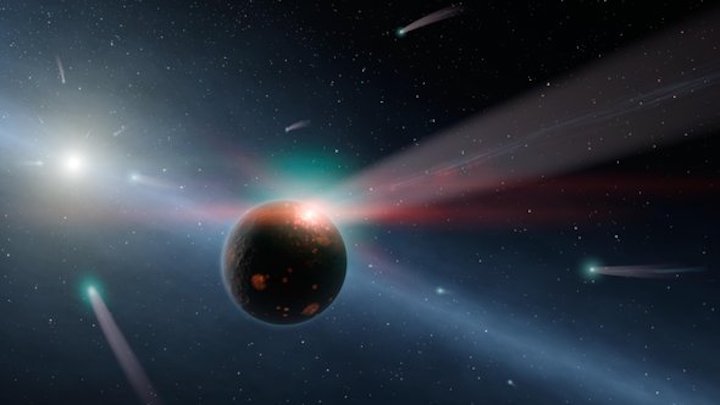5.02.2019
Far beyond our sun, astronomers have discovered comets bombarding a young solar-type star—and possibly its inner planets

This artist's conception illustrates a storm of planet-pummeling comets around Eta Corvi, a young star some 59 light-years away from our solar system. Credit: NASA and JPL-Caltech
A rain of comets is pouring down on a faraway young star, giving astronomers a new view of a process that shaped our own solar system billions of years ago.
When Earth was a young planet, cometary debris battered its surface, carrying organic material that may have helped life arise on our rocky world. In recent years scientists have spotted indirect evidence for a similar process around Eta Corvi, a solar-type star some 59 light-years away that is slightly larger and three times younger than our own sun. Now newly observed flickers of gas thought to emanate from comets evaporating in the heat of the star are providing stronger evidence for both hidden planets and cataclysmic impacts.
Detected by University of California, Berkeley, astronomer Barry Welsh and his colleague Sharon Montgomery of Clarion University in Pennsylvania, these whiffs of gas may have a deep albeit indirect connection to our own cosmic home. When our sun was the same age as Eta Corvi, most theorists believe gravitational interactions between our solar system’s outer planets swept the icy leftovers of their formation inward to pummel Earth and the other rocky planets. This “late heavy bombardment” (LHB) may have been crucial for Earth’s habitability and our very existence here, delivering life-giving water and organic compounds from deep storage in the outer solar system. And something much like it seems to now be occurring around Eta Corvi. Welsh calls the star a “potential solar system in the making.”
A rain of comets is pouring down on a faraway young star, giving astronomers a new view of a process that shaped our own solar system billions of years ago.
When Earth was a young planet, cometary debris battered its surface, carrying organic material that may have helped life arise on our rocky world. In recent years scientists have spotted indirect evidence for a similar process around Eta Corvi, a solar-type star some 59 light-years away that is slightly larger and three times younger than our own sun. Now newly observed flickers of gas thought to emanate from comets evaporating in the heat of the star are providing stronger evidence for both hidden planets and cataclysmic impacts.
Detected by University of California, Berkeley, astronomer Barry Welsh and his colleague Sharon Montgomery of Clarion University in Pennsylvania, these whiffs of gas may have a deep albeit indirect connection to our own cosmic home. When our sun was the same age as Eta Corvi, most theorists believe gravitational interactions between our solar system’s outer planets swept the icy leftovers of their formation inward to pummel Earth and the other rocky planets. This “late heavy bombardment” (LHB) may have been crucial for Earth’s habitability and our very existence here, delivering life-giving water and organic compounds from deep storage in the outer solar system. And something much like it seems to now be occurring around Eta Corvi. Welsh calls the star a “potential solar system in the making.”
The new observations could help improve our understanding of what happened in our own solar system when the sun was the same age as Eta Corvi is today. “If you look at our own solar system, people are arguing about the late heavy bombardment,” Lisse says. He adds there is great debate over whether this epochal event in solar system history occurred as a single large spike or, instead, Earth and the other terrestrial planets experienced a slower, more gradual battering. If Eta Corvi is truly a reliable analogue for the solar system, he says, it can help us constrain the lingering uncertainties about the timing and magnitude of the LHB—which in turn could enhance our understanding of this process as it unfolds around other stars. “That's what we’d really like to learn about,” he says.
HOPE FOR THE FUTURE
So far, no planets have been confirmed orbiting Eta Corvi but indirect evidence for their existence is strong. Whereas the exact boundaries of our solar system’s Kuiper Belt are somewhat nebulous and diffuse, Eta Corvi's outer belt is narrow and better defined. According to David Nesvorny, a theorist at the Southwest Research Institute who models the early development of our solar system, a narrow outer belt strongly suggests the presence of at least one gas giant at the belt’s outskirts.
Nor are chains of planets unusual. Multiplicity is the norm for exoplanetary systems, and most every sort of multiplanet system should readily hurl material inward. At present most exoplanet-detection techniques work best for finding worlds close to their stars, but Nesvorny says he would not be surprised to find chains of planets extending into the outer reaches of alien planetary systems. The solar system’s outer planets create such a chain, although Jupiter’s massive gravity more often than not ejects material into interstellar space rather than ferrying it closer to the sun.
Welsh and Montgomery plan to continue observing Eta Corvi to provide further confirmation of the tantalizing cometary signal. Lisse says a new generation of large ground- and space-based telescopes slated to begin operations next decade might be able to image the inner ring to see more clearly what is happening there—perhaps even revealing the star’s hidden planets. In the meantime Lisse and his colleagues have used Spitzer and NASA’s Chandra x-ray space telescope to monitor the star, ruling out supermassive worlds five to 10 times as large as Jupiter; other observations have set an upper limit of six Jupiter masses on any planets around Eta Corvi. It may be only a matter of time until astronomers actually see the midsize multiplicity of worlds that must lurk there, and with them gain a deeper glimpse into one of the most violent chapters in our solar system’s history.
Quelle: SCIENTIFIC AMERICAN

